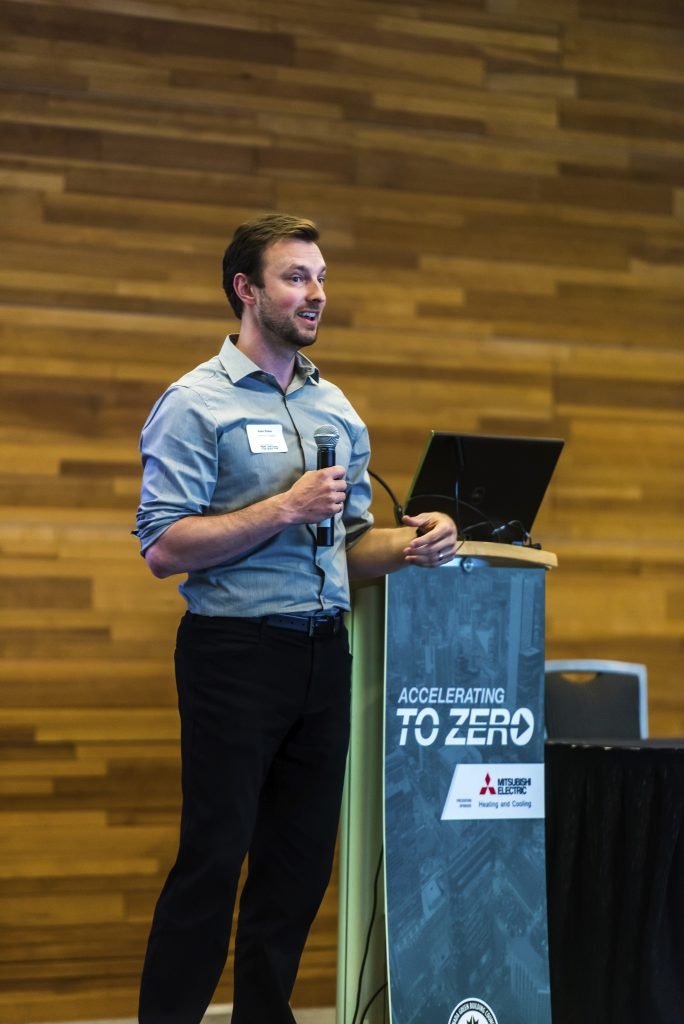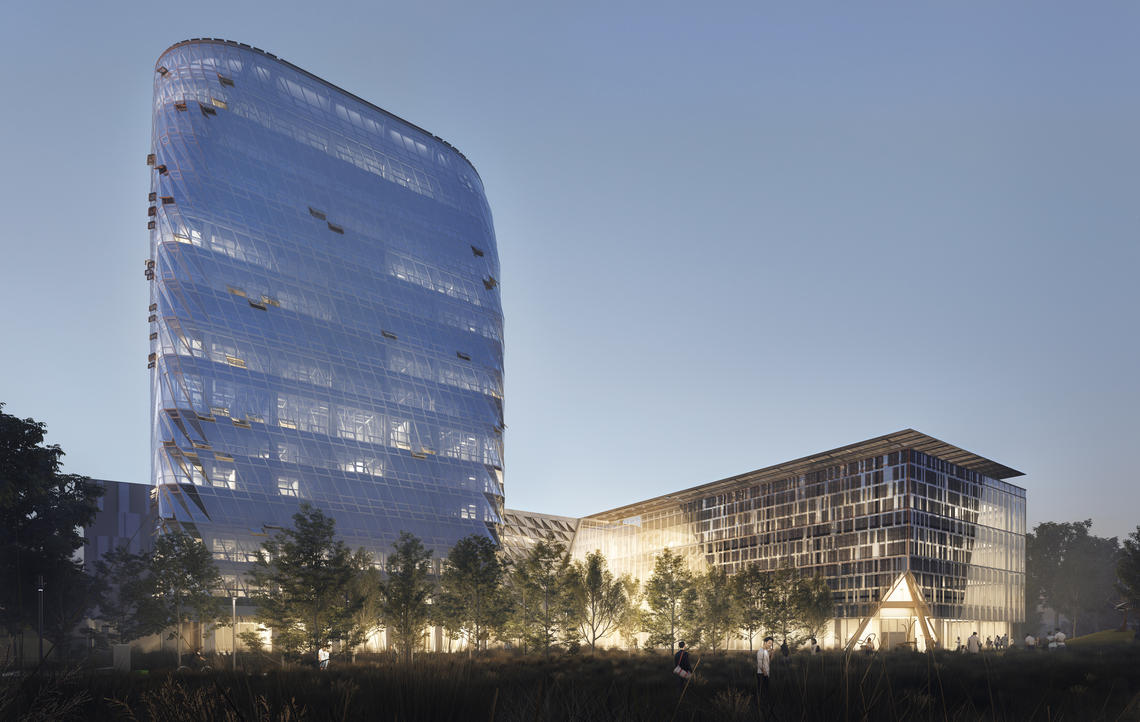By David Dodge and Kay Rollans
The University of Calgary — yes, that University of Calgary, the one at the heart of Canada’s conventional fossil fuel industry — has turned their ‘60s-era brutalist MacKimmie Library into a building designed to reach net-zero carbon emissions.


The transformation is all part of the university’s 2019 Climate Action Plan, which aims to create a carbon-neutral campus by 2050. The university hopes the plan will spark innovation and accelerate the transition to a clean growth economy.
“The inspiration for this project really stemmed from our institutional sustainability strategy. One of the key goals within that is for the campus to become carbon neutral and for us to be a Canadian leader in high-performance green buildings,” says Adam Stoker, an engineer in the U of C’s office of sustainability.
A Zero Carbon building
The MacKimmie Library project was conceived around the time the Canada Green Building Council was developing a new Zero Carbon Building Standard. The building was one of 16 across Canada that the council chose to pilot the new standard.
According to the Canada Green Building Council’s website, for a building to meet the Zero Carbon Building Standard it must demonstrate zero carbon balance, include highly efficient envelope and ventilation systems, and have onsite renewable energy systems able to provide at least of five per cent of the building’s total energy consumption.


“We recognized quickly that the existing mechanical, electrical, and building envelope pieces were well beyond their serviceable life. However, we realized that the structure was still in excellent condition,” says Stoker.
In terms of reducing carbon emissions, it’s no small matter that the MacKimmie building’s concrete structure was recycled rather than torn down and rebuilt from scratch. Concrete production contributes six to 10 per cent of all human-based carbon emissions. More than 90 per cent of materials from the old building were recycled.
Double-skinned façade dances with Mother Nature
“One of the unique design features in the complex is the application of a double-skin façade,” says Stoker. This is a design feature that uses air as insulation by trapping a two-layered, glass outer wall. As Stoker explained, these walls act “like a warm blanket wrapped around the building providing a mini greenhouse where we can better insulate the building from the exterior environment and manage the passive energy sources that we have to work with here in Calgary.”
In the MacKimmie building, the two glass walls are engaged in a constant, automated dance with Mother Nature. “The double-skinned facade responds to changing weather conditions from day to night and through the season,” said Stoker. “The windows open and close and the blinds rise and fall in response to things like the movement of the sun, external winds, and external temperatures.”
This automated dance allows the building to optimize its internal climate by accessing the free ventilation, heating, and cooling of the outdoors, while being able to shade itself when necessary. But it’s not all automated. “The shades and the interior windows can be opened and closed by occupants,” Stoker said — something you can rarely do it a big building.

Solar power for more efficient building
About two-thirds of the building’s total electricity comes from solar modules on the roof and walls of the building. The remaining third is provided by the U of C’s district energy system (DES), a natural gas–fired system that produces electricity and hot water.
While solar provides 66 per cent of the electricity, it’s continued reliance on natural gas in DES throws a wrench into the building’s larger goal: to reach zero emissions.
“Net-zero is something we feel that we’ve got to demonstrate through operation. We’ve designed it to be net-zero but really the proof is in the pudding,” says Stoker. To reach carbon neutrality, the building will have to offset the DES’s use of natural gas. Time will tell if they are able to balance these with the renewable energy the building generates.
Decarbonizing the district energy system
Of course, there would be fewer emissions to offset if the DES were less reliant on natural gas. Decarbonizing the U of C’s DES is part of the university’s Climate Action Plan.
As it stands now, the current DES is expected to reach the end of its useful life in 2035. The U of C plans to convert the current natural-gas fired DES into a low-temperature, low-carbon system that integrates energy storage and smart grid technologies. This type of low-temperature system largely relies on renewable energy sources such as solar thermal, geothermal thermal and sewer heat. These types of systems often use heat pumps to efficiently move heat through the system.
MacKimmie Net-Zero at a glance
- More than 90 per cent of the construction and demolition waste produced during the retrofit was recycled;
- 3,000 metric tonnes of concrete was recycled;
- Reusing the concrete structure avoided 3,300 metric tonnes of carbon emissions;
- A 150,000 litre cistern captures rainwater, which supplies the 150 water closets in the building;
- 66 per cent of the building’s energy is supplied by a one-megawatt solar system;
- More than 10 projects, currently being explored as part of the UofC’s Learning Lab Initiative, using the MacKimmie project as their model.

Carbon Neutral by 2050
The MacKimmie project is just the beginning of a wider net-zero movement on the U of C campus, and a larger goal to reach carbon neutrality by 2050.
On the way to 2050, however, the U of C 2019 Climate Action Plan calls for 73,000 tonnes in emissions reductions by 2030. If all goes well, 14 per cent of these reductions will be met through new, energy-efficient and net-zero construction and development on campus. Retrofitting already existing buildings should contribute another 41 per cent, and the use and production of green energy will make up the final 45 per cent.
How the MacKimmie project will inform these future U of C projects is uncertain at this point, but these plans and goals give reason to be hopeful. Still, reaching these emissions reduction targets will require aggressive action on new and old buildings.
Adam Stoker is an engineer with the Office of Sustainability at the University of Calgary. He will be presenting the University of Calgary MacKimmie Net-Zero project on October 8 at the Alberta Sustainable Building Symposium (Oct. 7 – 9) in Edmonton. The theme of the day will be “Accelerating to Zero” and will feature a series of events that explore what it takes to achieve net-zero buildings.

